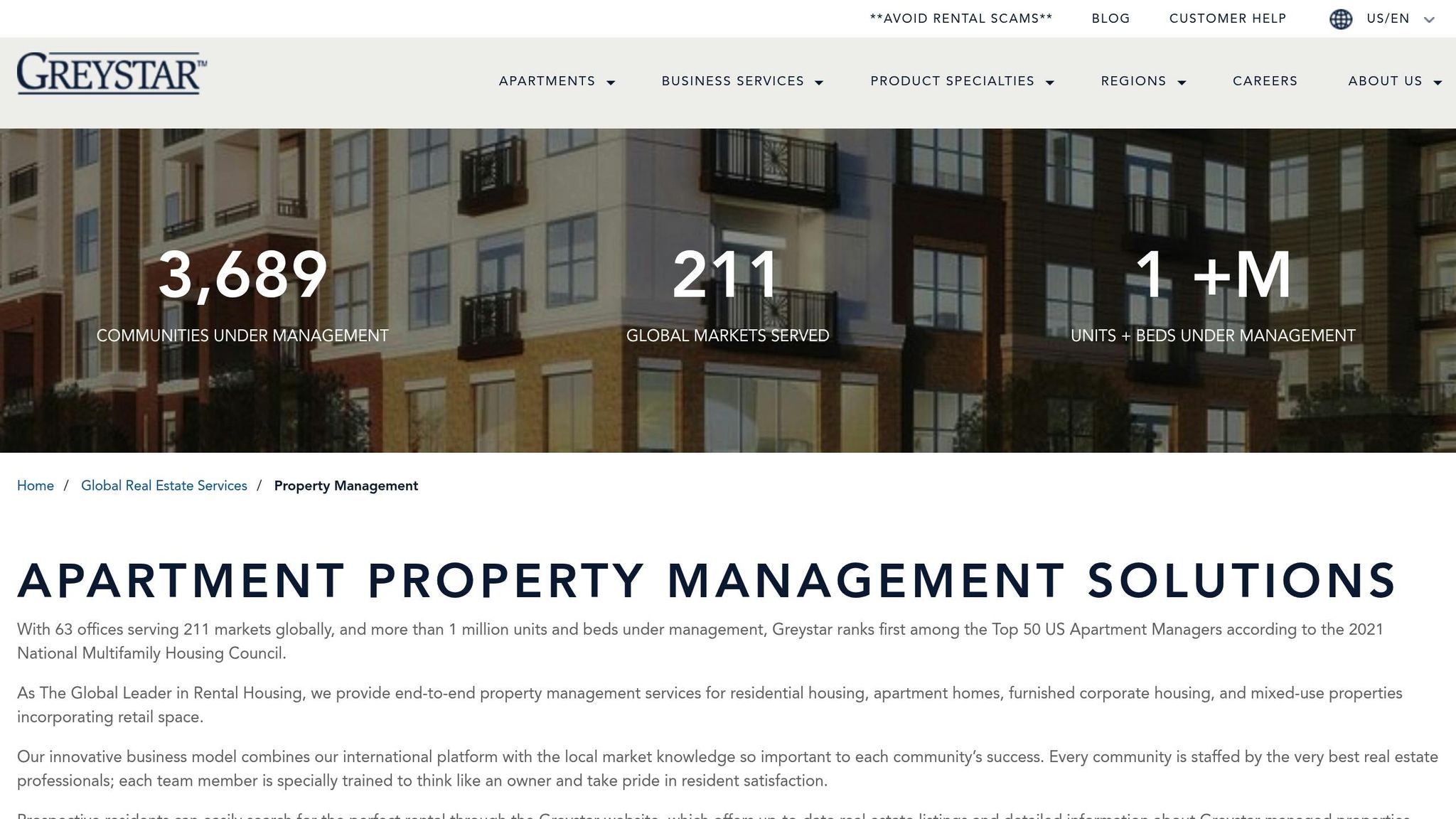How National vs. Regional Property Managers Operate Differently

National and regional property management companies operate differently in key areas like scale, decision-making, vendor setup, and technology.
- National Companies: Operate across multiple states, use standardized processes, and invest in large-scale technology. They focus on consistency and efficiency but may lack local market responsiveness.
- Regional Companies: Focus on specific markets, prioritize local expertise, and build strong vendor relationships. They offer tailored services and faster decision-making but have fewer resources.
Quick Comparison
| Aspect | National Companies | Regional Companies |
|---|---|---|
| Geographic Reach | Multi-state and international | Localized to specific regions |
| Portfolio Size | Large-scale portfolios | Smaller, market-focused portfolios |
| Decision Speed | Slower due to corporate hierarchy | Faster with local management |
| Vendor Setup | Detailed, standardized processes | Streamlined and quicker |
| Technology | Enterprise-level systems | Targeted, user-friendly tools |
| Market Approach | Standardized operations | Customized, localized strategies |
National firms excel in scalability and resource allocation, while regional firms thrive on flexibility and local expertise. Vendors should align their strategies based on these differences to succeed in the property management industry.
Exclusive Interview with Marco Vartanian of Sullivan Property Management
Service Area and Portfolio Coverage
The size and geographic scope of property management companies play a huge role in shaping their strategies and relationships with vendors. These differences highlight how national and regional firms operate in distinct ways.
National Companies: Expansive Multi-State Operations
National property management companies oversee properties across numerous states. Take Greystar, for example - they manage properties in 250 markets through 63 offices, handling over 1 million units and beds worldwide [1][4]. This wide reach allows them to leverage economies of scale, making it easier to invest in technology, workforce development, and marketing initiatives [2].
In February 2024, Wood Partners transitioned its management division - around 38,000 units across 17 states - to Greystar. This move gave employees access to more extensive resources and infrastructure [2].
"I have economies of scale, which allows me to be more effective. To invest in the technology, to invest in the people and to invest in marketing is becoming harder to do in this part of the business." - Mike Clow, Executive Managing Director of Greystar's U.S. Real Estate Services [2]
Regional Companies: Localized Expertise and Focus
Regional property management firms, while smaller in geographic scope, excel in understanding local markets. Capstone, for instance, operates in close to 80 cities [3], managing properties within specific, well-defined areas.
Regional firms shine in several areas:
- Local Market Knowledge: They have a deep understanding of neighborhood trends and property values.
- Vendor Relationships: Strong ties with local vendors allow for efficient and cost-effective services.
- Personalized Service: They offer more tailored management solutions to meet the unique needs of property owners.
For example, Oak City Properties in South Orange County, California, provides direct tenant communication and uses local vendor networks to manage maintenance effectively and affordably [6].
| Aspect | National Companies | Regional Companies |
|---|---|---|
| Geographic Coverage | Multi-state and international | Focused on specific areas |
| Portfolio Size | Large-scale portfolios | Smaller, market-focused portfolios |
| Market Approach | Standardized processes | Customized, localized strategies |
| Vendor Relations | National contracts and bulk pricing | Strong local partnerships |
| Resource Allocation | Corporate-level resources | Investments in local markets |
When choosing between national and regional property managers, property owners need to weigh their priorities. National firms bring extensive resources and consistency, while regional companies offer hands-on management and a deep understanding of local markets.
Company Structure and Decisions
How a property management company is structured and how it makes decisions play a big role in its efficiency and relationships with vendors. These differences in structure often reflect their service areas and business priorities.
National Firms: Corporate Hierarchy
National property management companies usually have a more intricate, multi-layered structure. Their operations are standardized across regions, which brings both advantages and challenges.
| Aspect | Characteristics | Impact |
|---|---|---|
| Decision Flow | Requires multiple approvals | Slower review and response times |
| Management Layers | Numerous management levels | Ensures consistency but adds complexity |
| Resource Allocation | Centralized budgeting | Provides uniformity but limits flexibility |
| Policy Implementation | Universal standards | Reduces local customization |
While this structure allows national firms to closely monitor brand performance, it also leads to increased costs due to overlapping roles [7].
Regional Firms: Local Management
Regional property management companies take a more straightforward approach, favoring quicker decision-making and better responsiveness to local market conditions. Their managers focus on:
- Direct Communication: Using face-to-face interactions for handling complex decisions [8].
- Team Empowerment: Allowing staff to make decisions without constant oversight [9].
- Personal Oversight: Conducting property inspections to show support and value for staff efforts [8].
- Local Adaptability: Quickly adjusting strategies to meet local market demands [5].
This leaner structure helps regional firms operate at lower costs compared to their national counterparts [7].
Vendor Setup and Purchasing
The way vendors are set up varies greatly depending on the size and pace of decision-making within a property management company. National companies tend to follow a standardized, detailed process, while regional firms often prioritize speed and simplicity.
National Companies: Standardized Processes
National property management companies rely on strict, uniform vendor requirements to maintain consistency across multiple states. These processes are designed to ensure quality and compliance at every level.
Take NRP Group, for example. Their vendor setup process includes the following steps[10]:
- Agreeing to the Vendor Management Program
- Completing a RealPage Vendor Credentialing application
- Paying an annual fee
- Providing a W-9 and proof of insurance
- Signing a standard vendor agreement
- Passing a background check
- Submitting contractor licenses as required
While this thorough process can take up to six months[13], it brings long-term benefits. For instance, automated systems used in these workflows can reduce invoice processing costs by as much as 80%[11]. However, this level of structure contrasts sharply with the more flexible methods employed by regional firms.
Regional Companies: Faster and Simpler
Regional property management companies, on the other hand, focus on efficiency. Their vendor setup process is streamlined to prioritize speed while still meeting essential quality standards. This process typically involves:
- Direct communication with vendors
- A simplified approval system
- Basic documentation requirements
- Local reference checks and insurance verification
This leaner approach allows regional firms to onboard vendors quickly without sacrificing service quality. Their local presence also gives them an edge in resolving issues promptly and keeping costs competitive through reduced overhead[14].
Katie Schieffer, CAM Regional Vice President, highlights the importance of fostering positive vendor relationships in these fast-paced environments:
"Being professional and still courteous even when there is frustration is key. I feel that client vendor relationships are a 2-way street and treating them with respect and humility is going to make them want to do work for you in the future."[12]
This focus on professionalism and mutual respect helps regional companies maintain strong, effective partnerships with their vendors.
Software and Systems
Property managers, whether operating on a national or regional scale, rely on software solutions tailored to their specific needs. These tools not only streamline vendor onboarding but also shape the way operations are managed and optimized.
National Firms: Large-Scale Systems
For national property management companies, enterprise software is the backbone of their operations, helping them handle vast portfolios efficiently. The demand for these solutions is growing rapidly, with the market expected to jump from $22.05 billion in 2023 to $42.89 billion by 2030 [15].
These companies invest in platforms that offer features like:
| Feature | Purpose | Impact |
|---|---|---|
| Centralized Data Management | Unified access to data across multiple states | Eliminates data silos for 47% of digital workers [15] |
| AI-Powered Analytics | Analyzes staffing and prospect conversion rates | Boosts team productivity by 40% [19] |
| Automated Workflows | Standardizes operations across locations | Cuts operational costs by 15% [19] |
| Cloud-Based Integration | Provides real-time updates | Supports multi-state operations seamlessly |
For instance, between 2000 and 2002, Western National Property Management implemented Yardi Systems' Voyager software to centralize data across 145 properties. This system now enables nightly reviews and sends automatic alerts for anomalies [16].
Marcie Williams, CEO of RKW Residential, highlights the advantages of such systems:
"We have been able to leverage data-driven insights from AI to evaluate staffing models, monitor prospect conversion and help us develop benchmarking for our leasing teams." [17]
While national firms focus on large-scale efficiency, regional firms take a more localized approach.
Regional Firms: Targeted Tools
Regional property managers lean toward solutions designed to meet the needs of smaller portfolios and local markets. These platforms emphasize:
- Simplified operations for easier management
- User-friendly interfaces to speed up staff training
- Integration with local service providers
- Affordable options that deliver quick returns on investment
One example is a Florida-based property management company that used AppFolio to enable three managers to meet with 7–10 new homeowners weekly, achieving an impressive 90% conversion rate [15].
Jenny Rosario, COO of Darcorp Mgmt Group, shares her experience with ResMan:
"ResMan has all the information we need housed within it. I don't need to go anywhere to get our accounting or our leasing. It's all together so we're able to look at operations and financials at the same time from the same system. We don't have to pull data out and build spreadsheets. You don't get this with any other property management system." [18]
Additionally, Camden Property Trust demonstrated the financial benefits of targeted tech investments, saving $25,000 annually by digitizing agreement processes with DocuSign [15]. These examples show how even focused, smaller-scale tools can deliver meaningful results.
Company Examples
Two companies provide a clear contrast in operational strategies: Greystar, which operates on a national scale, and Capstone, which focuses on regional management.
Greystar: National Scale

Greystar, the largest U.S.-based operator, manages around 650,000 units and beds nationwide, with a global portfolio valued at $115 billion [20]. Their expansive reach allows them to leverage centralized systems for efficiency:
| Aspect | Approach |
|---|---|
| Vendor Verification | Standardized NetVendor system |
| Purchasing | Centralized RealPage platform |
| Technology | Funnel system for 180,000+ units |
Melody Reid, Managing Director of Property Systems Engagement at Greystar, highlights their operational philosophy:
"In today's regulatory environment, and with clients who have dynamic needs, we have to be able to flex - but without losing the consistency that centralization provides. Our model ensures both." [24]
A notable example of their national partnerships is their December 2020 collaboration with Fetch Package. This partnership reflects their commitment to enhancing resident experiences. Toni Reeves, Executive Director for Greystar, explains:
"Fetch offers a really unique solution. Our residents schedule the delivery based on when it's convenient for their schedule. Fetch helps with every facet of package logistics including package quantities, package theft, delivery predictability, and the handling of oversized items. It also allows our on-site team members to focus on other critical tasks related to resident care." [20]
Greystar's approach demonstrates how national scale and standardized systems can drive efficiency and meet diverse client needs.
Capstone: Regional Focus

Capstone, on the other hand, operates with a localized strategy, focusing on nearly 80 cities [3]. Their portfolio includes seven multi-family communities with 1,938 units and 1,860 beds across three off-campus communities [22]. This regional focus allows Capstone to prioritize:
- Building direct relationships with clients and tenants
- Streamlining local operations
- Partnering with technology providers to address specific local needs
Their dedication to efficiency is evident in their proprietary systems designed to simplify vendor management. As they describe:
"We have created proprietary systems that virtually eliminate the time spent by the Property Management team on vendor identification, processing and maintenance. This system was created to help manage risk and reduce the workload associated with vendor management." [21]
Anthony Awkar, General Manager at Capstone, emphasizes the benefits of their technology choices:
"What we particularly like is that Yardi offers a Software as a Service (SaaS) solution that will allow us to implement a new platform quickly with less cost. Voyager will help us enhance the services we provide our customers without the headache of managing internally hosted technology systems." [23]
Capstone’s regional approach showcases how a focus on local operations and tailored solutions can create a more personalized and flexible management style.
Conclusion
National and regional property management companies present unique opportunities for vendors, each requiring a distinct approach to service.
| Aspect | National Companies | Regional Companies |
|---|---|---|
| Market Reach | Operate across multiple states with standardized processes | Concentrate on local expertise with adaptable methods |
| Decision Speed | Slower approval cycles due to corporate hierarchy | Quicker decisions through local management |
| Technology Requirements | Require integration with enterprise-level systems | Favor targeted, scalable solutions |
| Relationship Building | Focus on corporate-level partnerships | Emphasize direct, local relationships |
This comparison highlights the key differences that influence vendor strategies.
Industry trends further reinforce these distinctions. Over half of property management companies are shifting toward centralized administrative functions [25]. Marlee Murdock, Director of Operations and Transitions at Western Wealth Capital, explains:
"We found that even if there are small inconsistencies in standard tasks, we're leaving money on the table." [25]
Meanwhile, regional firms continue to thrive by leveraging their local expertise. JC Castillo, founder of Velo Residential, points out:
"We found that the personal connections our teams make onsite have a greater influence on the multifamily communities we manage." [25]
For vendors, success lies in adapting to these dynamics. National firms demand consistency and system integration, while regional firms value flexibility and a personal touch. Understanding these distinctions allows vendors to align their services effectively and build meaningful, lasting partnerships.
For more details on vendor approvals and strategies for regional services, check out our related posts.
FAQs
What are the main benefits of working with a regional property management company instead of a national one?
Choosing a regional property management company can offer property owners several key benefits that truly stand out:
- Deep Local Knowledge: Regional companies are well-versed in the local market, understand area-specific regulations, and are familiar with what tenants in the community need. This allows them to manage properties with a focus on the local landscape.
- Tailored Service: With a more hands-on approach, these companies often build closer relationships with both property owners and tenants, ensuring a more personalized experience.
- Quicker Responses: Their smaller size and localized operations mean they can address issues or adapt to market shifts more swiftly than larger, national firms.
For property owners seeking efficient, cost-conscious, and community-oriented management, regional companies are often a smart alternative to big-name competitors.
How do national property management companies stay consistent across different states while addressing local market needs?
National property management companies maintain consistent operations across states by leveraging centralized systems and modern technology. Centralized leasing teams oversee multiple properties, ensuring services are delivered uniformly and resources are allocated efficiently. This setup allows for faster responses to tenant inquiries and smooth management during busy periods.
To address local market variations, these companies use property management software and CRM tools that streamline processes while accommodating regional specifics. By balancing centralized oversight with localized adjustments, they create a cohesive brand experience across different markets.
How does technology impact the efficiency of national vs. regional property management companies?
Technology plays a major role in boosting the efficiency of property management companies, whether they operate nationally or regionally. However, their strategies for using technology often differ. National companies typically invest in large-scale, cutting-edge tools like AI and automation. These tools help streamline operations across multiple locations, offering features like tenant screening, automated maintenance requests, and centralized data management. The result? A consistent and efficient system that works seamlessly across the country.
Regional companies, by contrast, tend to focus on market-specific technologies designed to meet the needs of their local audience. This approach allows them to deliver more personalized services and respond to local demands effectively. However, these tailored solutions may not match the efficiency of the integrated systems used by national firms. While both types of companies use technology to enhance their operations, national firms often gain an edge in scalability and uniformity.